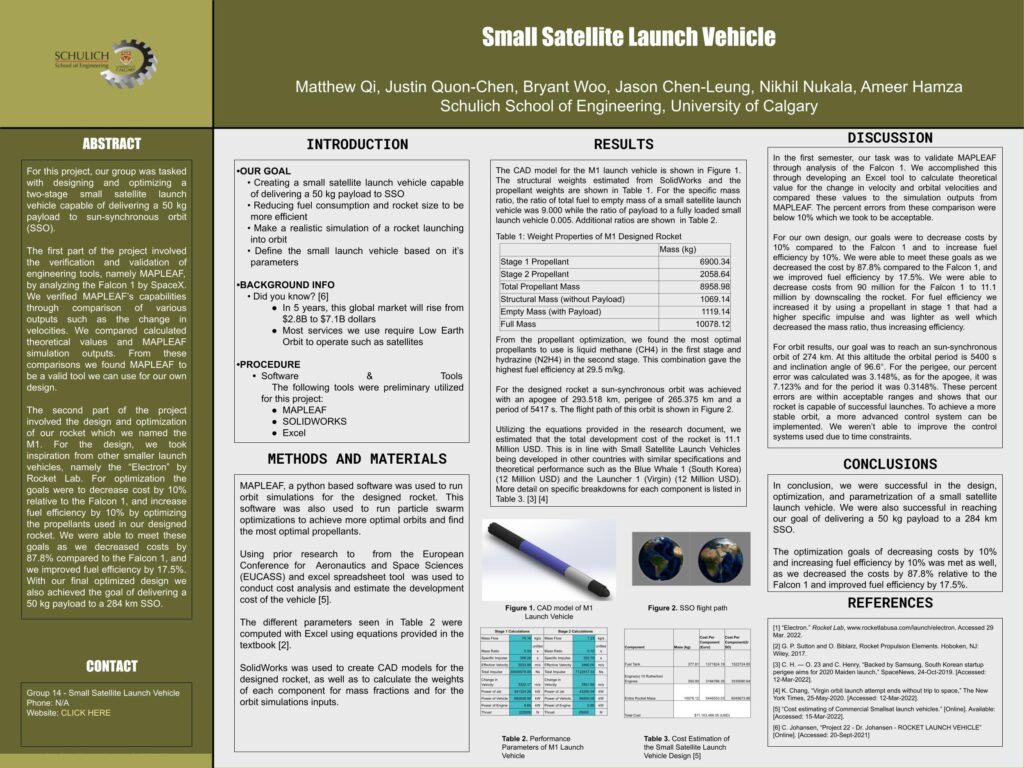Project Category: Mechanical
Join our presentation
About our project
Based on a market study it was determined that the small satellite global market is expected to grow from 2.8 Billion to 7.1 Billion in 5 years [1]. Services that require low earth orbit, Earth imagery, analytics, and the increase in space missions have drastically increased the demand for small satellites that are less than 500kg [2]. Multiple companies and countries have been investing in these launchers to ensure that they have the competitive edge and the ability to launch in space [2].
[3]
The project objective is to design and optimize a two-stage small satellite launch vehicle following verification and validation of engineering tools (MAPLEAF, OpenRocket, NASA CEA). The rocket should be capable of delivering a 50 kg payload to sun-synchronous orbit (SSO) while rivaling the performance, weight, and fuel consumption of the SpaceX Falcon 1. The goal is to improve fuel efficiency and the development and manufacturing costs of the rocket by at least 10 percent making it the preferred launch vehicle. We will be evaluating the aerodynamics, structures, and weight estimation of the launch vehicle. Developing and optimizing a conceptual design for comparison with Falcon 1 will serve to assist the Aerospace and Compressible Flow Research (AERO-CORE) as they develop a rocket motor and determine how these motors need to be scaled to fulfill the same design requirements.
Meet our team members
Matthew Qi – Design & Software Lead
Matthew was responsible for running orbit and optimization simulations within MAPLEAF. He also led in the design of the two-stage small satellite launch vehicle, specifically the fuel tank sizes and engine components, and overall rocket structure. He also debugged the MAPLEAF software which led to more successful results.
For project management, Matthew helped manage the design binder and keep it organized.
Jason Chen-Leung – External Communications Lead
Jason is the external communications lead, coordinating meetings and correspondence between the team, the sponsors, and the academic staff. In addition, Jason managed the team Gantt chart and ensured proper scheduling of key milestones.
On the technical side, Jason calculated and verified theoretical values for rocket performance, establishing baselines for design. He developed early simulations for the launch vehicle and later moved on to troubleshooting the main simulation branch. Jason also facilitated the creation of technical drawings and engineering graphics.
Justin Quon-Chen – Project Management Lead
In terms of project management, Justin focused on managing the team’s schedule and ensuring major deadlines were met, establishing the main meeting agenda, and ensuring accurate records of meetings were kept for each different meeting. Justin also worked to develop the technical presentation and organize the design binder.
For the technical aspects of this project, Justin worked on the CAD Model of the final launch vehicle design, estimation of the weight of the rocket, and computed the parameters and specifications of the small satellite launch vehicle. Justin also worked on the cost estimation of the project, and the initial launch simulations for the rocket, and helped debug some issues with the software MAPLEAF.
Bryant Woo – Internal Communications Lead
Bryant was responsible for overseeing different subsections of the project, coordinating specific deadlines to meet, and determining if the group was on track with the project schedule. Bryant’s role is to ensure that each group member is informed about meeting times while assisting in project management.
In the technical aspect of the project, Bryant had worked with the verification and validation process and also performed calculations for varying rocket specifications and visual design maintenance. In their free time, Bryant helped around the group with tasks that needed to be completed on time.
Ameer Hamza – Research Lead
Ameer was responsible for researching the exploration of different alternatives, to ensure our optimization goal is achieved. Alongside additional research, Ameer was also responsible for validating different subsections of the project while ensuring our established deadlines are met. Ameer also assisted in varying rocket calculations
Nikhil Nukala – Verification Lead
Nikhil was responsible for the testing of the code, specifically checking if everything was working as intended. This would involve verifying the code and calculations. We had specific deliverables such as the 50 kg payload as well as sun-synchronous orbit and Nikhil’s role is to ensure that these deliverables are being met as well as keep track of additional optimizations. Additionally, Nikhil took a role in performing calculations using literature and values found through research for the two stages of the rocket. These results are the inputs in the MAPLEAF code. Aerodynamic calculations on the rocket, specifically lift and drag, is another area overseen by Nikhil to ensure that the simulated rocket is following the rules of physics.
Details about our design
HOW OUR DESIGN ADDRESSES PRACTICAL ISSUES
Our design will address practical issues for future space missions as it was optimized for an increase in performance with a reduction in price, structure, and mass. With more affordable costs, countries are able to increase the number of payloads or structures to deliver into orbit for an increase in services or space exploration provided on Earth.
WHAT MAKES OUR DESIGN INNOVATIVE
Some of the factors that heavily contribute to our design innovation are the fact that our designed rocket is far more efficient in terms of cost and fuel efficiency. Our design was intended to carry a 50 kg payload to orbit. We decided to innovate our design in a way that would still allow us to accomplish a sun-synchronous orbit around the earth while still being able to carry out our initial goal. This allowed us to use less material as well as expend less fuel for the same end result.
WHAT MAKES OUR DESIGN SOLUTION EFFECTIVE
In terms of effectiveness, we have thoroughly researched and simulated various scenarios to determine the most optimal flight performance. The engineering analysis involved simulating an ideal moment controller in order to maintain a stable orbit despite continuously changing the rocket parameters due to our ongoing optimization.
HOW WE VALIDATED OUR DESIGN SOLUTION
By finding standardized nomenclature and comparing it to our software, we have found a way to assert validation and verification practices in our simulations. This ensures that we have an appropriate solution with confidence that it will work and perform as expected.
The first step in verifying our design is confirming that the software MAPLEAF we were using produced accurate flight data results. We conducted this validation using the Falcon 1 as it is an existing rocket with clearly defined specifications and similar capabilities to what our sponsor is seeking. We specifically examined the change in velocity MAPLEAF computed from its simulation compared to theoretical flight data that was computed using the Tsiolkovsky rocket equation for the change in velocity. In the results, it was determined that MAPLEAF did produce accurate feedback for flight data.
The change in velocity for stage 1 and stage 2 was drastically different between the simulation and our calculations as seen in the left table. This is likely due to frictional and gravitational effects. The max changes in speed computed in MAPLEAF are smaller than the theoretical calculations from the rocket equation (where gravity is not considered).
The next stage of software verification was examining the orbit simulations that MAPLEAF produced. Going back to Falcon 1, the average velocity for this orbit was 7687 m/s with a standard deviation of 13.5 m/s. Using Excel we calculated the theoretical orbital velocity at 372 km to be 7688 m/s which is accurate to the simulation results and further verifies the validity of using MAPLEAF for running simulations.
| Altitude | Standard Deviation | Orbital Velocity | Standard Deviation | |
| MAPLEAF | 372 km | 10.7 km | 7687 m/s | 13.5 m/s |
| Excel Calculations | 372 km | – | 7688 m/s | – |
After the software was validated we focused on different prototypes to evaluate. There were a total of 2 prototypes created: starting with the M1-Ver.1, This version of our rocket design was used as a test model to see if a smaller model could successfully orbit which we were able to achieve.

The M1-Ver. 3 is the next prototype. This version came after our chosen design (M1-Ver. 2) and was initially used to try and achieve a higher sun-synchronous orbit but after some simulations, we found that if we wanted to achieve an orbit in the typical 600-800 km range we needed more fuel which would have increased costs so we decided to aim for a lower sun-synchronous orbit of 274 km.

No longer needing more fuel we went back to M1 Ver.2 which was originally made to be similar in weight to the Electron rocket to test how small we can make our rocket while still being able to reach our orbit goals.

SOLIDWORKS software was utilized to get the weight estimations for the rocket. The weight estimation results of the structural components are shown in this table. Version 1 and 3 are the prototypes and Version 2 is the final design. From this table, version 2 is the lightest. A note to add would be that these weight estimation results pertain to the shell of the rocket, and do not include any internal components such as payload attachments or engine components as we obtained those parameters from external sources. The material used in the final rocket design is Aluminum Alloy Plate 2219, we chose this material because it costs less and has a good balance of strength and low weight which makes it a great fit for our rocket. Also being an alloy it has good properties such as stress corrosion cracking resistance and high tensile strength[6].
FEASIBILITY OF OUR DESIGN SOLUTION
This design can be considered a very feasible way to launch an increased number of payloads into space since it accomplishes both the sun-synchronous goal as well as the goal of being able to carry a 50 kg payload while being considerably less expensive with the same amount of orbit stability that would be seen in other traditional launch vehicles.
Utilizing the research provided by the European Conference for Aeronautics and Space Sciences to estimate the development costs of rocket development, we estimated that the total development cost of the rocket is 11 Million USD. This is in line with Small Satellite Launch Vehicles being developed in other countries such as the Blue Whale 1 and the Launcher 1 developed by Virgin both of them being approx. 12 Million USD [4] [5]. This is significantly lower than the 90 Million USD that was required to develop the Falcon 1, as such, makes this a more viable option for us.
Partners and mentors
This would not be possible without the participation and assistance provided by Dr. Johansen, Colin Hill, Thomas Mathias, and Dr. Egberts. The knowledge and contributions given are greatly appreciated and have our gratitude. Special thanks to Henry Stoldt for granting us permission to use the MAPLEAF Software and guiding us throughout the year for our Capstone Project.
Our photo gallery
CAD Model of Designed Rocket
Expanded View of the Rocket CAD Model
Note: Units are in mm for the Dimensions
Orbital Flight Paths from Simulation Results


Design Fair Poster

For a more detailed view please visit here
References
- “Small satellite market,” Market Research Firm. [Online]. Available: https://www.marketsandmarkets.com/Market-Reports/small-satellite-market-150947396.html?gclid=CjwKCAjwwsmLBhACEiwANq-tXHRgTJn8IuAit090BhPHv4n-ZAUx7z4dvEqZ1yiD_jHo4lYjlJCKqhoCr2MQAvD_BwE. [Accessed: 08-Oct-2021].
- C. Johansen, “Project 22 – Dr. Johansen – ROCKET LAUNCH VEHICLE” [Online]. [Accessed: 20-Sept-2021]
- “Spaceflight now: Breaking news: Collision between rocket stages doomed falcon 1,” Spaceflight Now | Breaking News | Collision between rocket stages doomed Falcon 1. [Online]. Available: https://spaceflightnow.com/falcon/003/update.html [Accessed: 01-Apr-2022].
- C. H. — O. 23 and C. Henry, “Backed by Samsung, South Korean startup perigee aims for 2020 Maiden launch,” SpaceNews, 24-Oct-2019. [Online]. Available: https://spacenews.com/backed-by-samsung-south-korean-startup-perigee-aims-for-2020-maiden-launch/. [Accessed: 12-Mar-2022].
- K. Chang, “Virgin orbit launch attempt ends without trip to space,” The New York Times, 25-May-2020. [Online]. Available: https://www.nytimes.com/2020/05/25/science/virgin-orbit-launch-time.html. [Accessed: 12-Mar-2022].
- “Aluminium alloy 2219,” Aluminium Alloy 2219 | Aircraft Materials. [Online]. Available: https://www.aircraftmaterials.com/data/aluminium/2219.html?fbclid=IwAR0LkYuDWQBrejFm2EK2kdBLzFAdRS8_rIDRrlIVG3339ydD4C4wzqKFQNw [Accessed: 12-Mar-2022].
